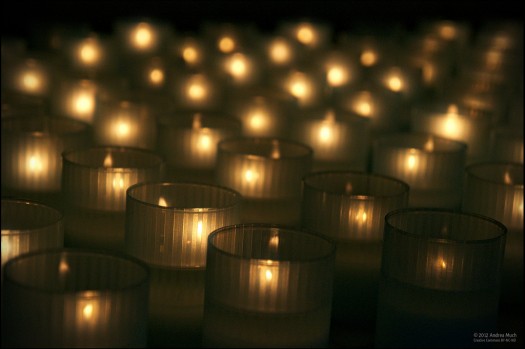
The Geography of Mourning

much0 / Creative Commons / Flickr
Sandy Hook: The school’s baseball field where I first learned how to hit a ball and mean it. Where my brother had his tenth birthday party and I wore a pair of pink shorts printed with gray kittens. Where the outsized, green footprints of our mascot, the Green Giant, formed a path to the entrance of the school. Where my mother taught off and on. Where I wrote a sequel to The Hobbit for Mrs. Toomey, who was seriously unimpressed. Where, on a stormy day, Mrs. Hansen-Bolt let us gather at the front of the room and huddle together as she opened up a book and began to read. Where we felt safe.
I wrote these memories feverishly while, in the background, I listened to the continuous coverage of the Sandy Hook shooting. It felt like a compulsive and involuntary act, a race to commit to memory images on an old filmstrip that might, at any moment, melt away. And in some ways, they will, the richness of these memories co-opted by a horror, a redrawing of a psychological map. The library where I sat with Harold and the Purple Crayon now the library where teachers hid their students, supplying them with paper and crayons. Telling them to color while twenty of their schoolmates were shot and killed.
This is the geography of grieving, where a place of life becomes a reminder of death, a reminder that threatens to eclipse the memories that came before. It’s a strange thing to watch a small hometown transformed into a monument, a memorial. Though the only truly remarkable thing lurking in this is how common that experience has become. Chardon, Ohio. Columbine, Colorado. Blacksburg, Virginia. Santee, California. Springfield, Oregon. Jonesboro, Arkansas. West Paducah, Kentucky. Pearl, Mississippi. The list goes on, each instance composed of a young person shooting and killing other young people, often concluding the act by killing himself.
There are memorials, both public and private, in all these towns. They are an important part of grieving, of remembering. But just the act of committing these instances to memory serves to place them in the past. What does it mean to memorialize an occurrence that will, based on historical trend, soon happen again in another town?
“Then there’s tiny Sandy Hook, a bit of small-town Americana that could have sprung, fully formed, from a Norman Rockwell painting.” —Philadelphia Inquirer
We crave shorthand. In his story “On Exactitude in Science,” Borges writes of an Empire where “the map of a single Province occupied the entirety of a City, and the map of the Empire, the entirety of a Province.” As the media dives deeper into its memorializing, deeper into piecing together a narrative of why, a two-fold fear creeps up: First, that a town this small cannot survive this amount of heartbreak, and second, that the weight of this moniker, Second Deadliest, will impose a permanent, unwanted memorial, a map that subsumes the many maps—messy, dull, joyful—that came before.
The map is not the territory. An odd incantation, but one worth repeating while confronting the endless descriptions of Sandy Hook.
“Evil visited this community today,” Gov. Dannel P. Malloy told reporters, “and it is too early to speak of recovery.” I’m willing to agree with Malloy if I can redefine the intent of his words, reframe them as a warning about our complicity. There is nothing more seductive than viewing this violence as an isolated incident. It is not. Evil does not visit. It has a permanent residence in every town. I don’t mean this in a strictly religious sense. I’m thinking more of Arendt’s “banality of evil.” The evil here is to treat this as an aberration, to ignore our complicity.
The central shock of victims so young, victims who, as one reporter wrote, “still had their baby teeth.” And the twenty-year-old gunman, Adam Lanza, who killed himself: A “scared young boy who was very nervous around people.” Innocent children, read headlines. The question of guilt. The question of when a child ceases being innocent. The craving for a simple study in contrast: innocent and guilty. The evil and the good. When reporting the death toll, some publications state “26 dead” in headlines. A few state “27 dead,” including Lanza’s mother who was killed at her home. Fewer still include Lanza in the total, “28 dead,” preferring to acknowledge his death separately: The gunman killed himself.
It is unconscionable for us to stop at the abstraction of “why” without an eye to the concrete: Insufficient gun control laws, a healthcare system in which mental health issues consistently get short shrift, an education system that is told to consistently perform better with fewer resources—resources like school counselors and teachers with special needs training.
Cultural critic Slavoj Zizek (echoing Edmund Burke) writes that, sometimes, “doing nothing is the most violent thing to do.”
One Sandy Hook boy, whose teacher locked his class into the bathroom to try to protect them from the shooter, recalled that there was nothing to do but play tic-tac-toe over and over. “It was so boring and so scary,” he said.
The intensity of trying to distract yourself, feeling impotent and helpless as violence rages right outside a barricaded door.
Perhaps this is the true definition of what separates an adult from a child: Not just the ability, but the responsibility to act—to prevent what is preventable, to refuse the overly simplistic narratives that peg “good” against “evil,” and to peel back the maps that hide the complex truth from view, so that we might create memorials that are worthy of the dead.
———
About the author: Onnesha Roychoudhuri is a Brooklyn-based writer and editor. A 2011 and 2012 Pushcart Prize nominee, her writing has appeared in outlets such as n+1, McSweeney’s, Opium, Wag’s Review, the Boston Review, the Nation, The American Prospect, Salon, Mother Jones, In These Times, and the Huffington Post.
